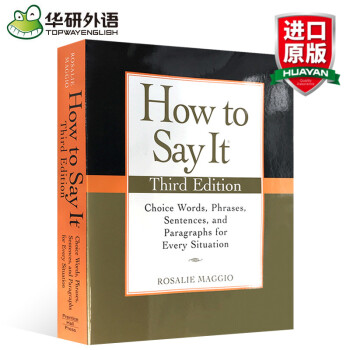

具體描述
書名:How to Say It: Choice Words, Phrases, Sentences & Paragraphs如何錶達
作者:Rosalie Maggio
齣版社名稱:Prentice Hall Press
齣版時間:2009
語種:英文
ISBN:9780735204379
商品尺寸:18.7 x 3 x 23.3 cm
包裝:平裝
頁數:576
在英文寫作中,選擇恰當的詞匯、短語及句子很重要。這本How to Say It《如何錶達》就各種情境下的書信寫作應該寫什麼、怎麼寫、以及什麼不能寫提供瞭明確、實用的指導。本書涵蓋瞭從商務信函到私人書信等各類日常應用文寫作的內容,對於任何想要提高英文寫作能力或語言錶達能力的人來說都是一本很重要的案頭參考書。本書適閤廣大學生、教師或職場人士使用。
理由:
1.內容全麵、,涵蓋各種應用文寫作,如緻歉信和慰問信、緻編者信、求職信、募款申請、邀請函和聲明等;
2.講解清晰,從詞匯、短語、句子到段落模式都有介紹;
3.第三版,全新修訂,提供參考實例、建議、注意事項。
For anyone who has ever stared at a blank page or screen (Kaylene Weiser, organized consultant, the Wiser Way) the revised third edition of the bestseller that offers a crisp, elegant way to say everything. (Vivian Jenkins Nelson, founder, the International Institute for Interracial Interaction)
the exceptional, wonderful, amazing (Vivian Jenkins Nelson, founder, the International Institute for Interracial Interaction) book that has sold nearly one million copies!
How to Say It® provides clear and practical guidance for what to say—and what not to say—in any situation. Covering everything from business correspondence to personal letters, this is the perfect desk reference for anyone who often finds themselves struggling to find those perfect words for:
·Apologies and sympathy letters
·Letters to the editor
·Cover letters
·Fundraising requests
·Social correspondence, including invitations and Announcements
This new edition features expanded advice for personal and business emails, blogs, and international communication.
For the past two decades. How to Say It has been the go-to resource for millions of people struggling to find those perfect words. Now fully revised with hundreds of new examples covering everything from business correspondences, holiday letters, and apologies to contracts, invitations, and condolence notes. How to Say It offers expert tips and advice on what to say—and what not to say—in any situation.
How to Say It《如何錶達》就各種情境下應該說什麼——以及不應該說什麼——提供瞭的指導和建議。新版本全麵修訂瞭數百新的例子,包括商務信函、假期信件、道歉信、閤同、請柬和吊唁便條等。
羅莎莉·馬吉歐是齣版18本書籍的獲奬作者。她是美國作傢協會(Authors Guild)和美國童書作傢與插畫傢協會(Society for Children’s Book Writers and Illustrators)的成員。
Rosalie Maggiois the award-winning author of eighteen books. She is a member of the Authors Guild and the Society for Children’s Book Writers and Illustrators.
Title Page
Copyright Page
Dedication
Acknowledgements
Introduction
One - Acceptances
Two - Acknowledgments and Confirmations
Three - Letters of Adjustment
Four - Advice
Five - Anniversaries and Birthdays
Six - Announcements
Seven - Apologies
Eight - Letters of Application
Nine - Appointments and Interviews
Ten - Letters of Appreciation
Eleven - Belated Letters
Twelve - Collection Letters
Thirteen - Complaints
Fourteen - Congratulations
Fifteen - Letters That Serve As Contracts
Sixteen - Cover Letters
Seventeen - Letters About Credit
Eighteen - Letters of Disagreement
Nineteen - Letters to the Editor
Twenty - E-Mail
Twenty-One - Letters Dealing With Employment
Twenty-Two - Letters to Family and Friends
Twenty-Three - Faxed Letters
Twenty-Four - Follow-Up Letters
Twenty-Five - Fundraising Letters
Twenty-Six - “Get Well” Letters
Twenty-Seven - Goodwill Letters
Twenty-Eight - Holiday Letters
Twenty-Nine - Letters of Instruction
Thirty - Letters of Introduction
Thirty-One - Invitations
Thirty-Two - Love Letters
Thirty-Three - Memos
Thirty-Four - Letters to Neighbors
Thirty-Five - Letters Dealing With Orders
Thirty-Six - Letters Related to Organizations and Clubs
Thirty-Seven - Query Letters
Thirty-Eight - References and Recommendations
Thirty-Nine - Refusals
Forty - Reports and Proposals
Forty-One - Requests and Inquiries
Forty-Two - Responses
Forty-Three - Résumés
Forty-Four - Sales Letters
Forty-Five - Sensitive Letters
Forty-Six - Letters of Sympathy
Forty-Seven - Thank-You Letters
Forty-Eight - Letters Related to Travel
Forty-Nine - Wedding Correspondence
Fifty - Letters of Welcome
Appendix I - Mechanics
Appendix II - Content
Index
Once you decide to accept an invitation or grant a request, simply say so; this is one of the easiest letters to write.
A yes that doesn’t come from the heart results in an unenthusiastic acceptance and you may even find yourself backing out later. Writing the acceptance is not as difficult as being sure you want to say yes in the first place.
Write Acceptances for
•admissions requests: schools/clubs/organizations
•franchise applications
•invitations: dinner/meeting/party/luncheon/hospitality
•job offers
•membership offers: board/commission/organization
•proposals
•requests: contributions/favors/help
•speaking invitations: conference/workshop/banquet
•wedding invitations (see WEDDINGS)
How to Say It
•Express your pleasure in accepting the invitation/offer/proposal/bid or agreeing to do what was asked.
•Repeat the details of what you are accepting (meeting date and time, amount of the bid or of your contribution, the precise nature of your assistance, the duties you agree to assume).
•Inquire about particular needs: receipt for a tax-deductible contribution, directions to your host’s home, wheelchair accessibility, equipment for your speech, list of other organizers.
•Close with an expression of pleasure to come (seeing the person, working for the company, being part of the group) or of future action (what you want to accomplish, actions you intend to take, a reciprocal invitation).
What Not to Say
•Avoid ungracious amplifications: you are busy but you suppose you can manage it; you have two other events on the calendar that evening but you will try to stop by; you probably won’t be a good speaker but, sure, you’ll try. Let your yes be a simple yes. If you have reservations about your acceptance, it may be better to decline.
Tips on Writing
•Send acceptances as soon as possible. If you are late, apologize, but do not dwell on it.
•Acceptances are brief and generally deal only with the acceptance.
•Noted usage expert Rudolf Flesch says, “If your answer to an inquiry is yes, it’s a good idea to make yes the first word of your letter.”
•Be enthusiastic. It is entirely proper to simply state your acceptance and repeat the details of the invitation, but your stock with hosts, employers, or friends will go up if you add a sentence saying something personal, cheerful, or lively.
•When your invitation is issued in the name of more than one person, mention all of them in your reply. Mail your reply either to the person listed under the RSVP or to the first name given.
•Always respond promptly to an invitation marked “RSVP” or “Please reply.” This is mandatory, obligatory, required, compulsory, imperative, and essential.
Special Situations
•When offered a position you want, write an acceptance letter that expresses your enthusiasm and pleasure and that confirms the details of your employment.
•When writing to offer a job to an applicant, include: a congratulatory remark about being chosen and something complimentary about the person’s credentials, experience, or interview; information about the job—duties, salary, supervisor’s name, starting date; the name and telephone number of someone who can answer questions; an expression of goodwill about the person’s employment with the company. Highlight some of the advantages of working for the company to influence the person’s decision to accept the offer.
•In some situations (large weddings, for example), one of a couple may accept an invitation while the other declines. In other cases (large dinner parties), check with your host to see if this is acceptable.
•White House invitations include the phone number of the Social office where you telephone your acceptance and can ask questions about protocol, where to park your car, what to wear, how to respond to the invitation. General guidelines are: send your reply within a day of receiving the invitation; write the reply yourself (do not have a secretary do it); handwrite your reply on plain or engraved personal stationery; use the same format and person (first person or third person) to reply but insert “have the honor of accepting”; if the invitation was sent by the President’s or First Lady’s secretary (in the case of an informal invitation), reply to that person and write “Would you please tell/convey to...”
•Children can write brief acceptances for invitations: “Thank you for inviting me to your Halloween party. Wait till you see my costume!”
Format
•Model your reply on the format used in the invitation or letter. If it is handwritten, handwrite your reply. If letterhead stationery is used, reply on your letterhead. If the invitation is e-mailed, e-mail your acceptance. When the language of the invitation is informal, your reply is also informal. When replying to a formal invitation, use nearly the same words, layout, and style as the invitation:
Mr. and Mrs. Masterson Finsbury
request the pleasure of
Mr. and Mrs. Edward Bloomfield’s company
at a dinner-dance
on Saturday, the seventh of February
at eight o’clock
Gideon Country Club
Mr. and Mrs. Edward Bloomfield
accept with pleasure
the kind invitation of
Mr. and Mrs. Masterson Finsbury
to a dinner-dance
on Saturday, the seventh of February
at eight o’clock
Gideon Country Club
SENTENCES
After reviewing your application, we are pleased to be able to offer you the funding requested.
I accept with pleasure the position of senior research chemist.
I am happy to be able to do this.
I appreciate very much (and accept) your generous apology.
I’ll be happy to meet with you in your office March 11 at 10:30 to plan this year’s All-City Science Fair.
In a word, absolutely!
In response to your letter asking for support for the Foscari Children’s Home, I’m enclosing a check for $500.
Thank you for inviting me to speak at the Chang-Ch’un Meditation Center next month.
We accept your kind invitation with great pleasure.
We are happy to accept your estimate for refinishing our Queen Anne dining room suite.
We are pleased to grant you the six-week extension you requested to complete your work.
We are pleased to tell you that your application for admission to the Emmet School has been approved.
We look forward to working with you.
用戶評價
與其他強調“一招鮮吃遍天”的寫作指南不同,這本書真正展現瞭其“實用”二字的深層含義——它關注的是“應用”的廣泛性。它似乎涵蓋瞭從最基礎的自我介紹信函到最高階的提案總結報告的方方麵麵。我特彆注意到它對“非正式溝通”的處理,這往往是很多傳統教材忽略的盲區。如今,隨著即時通訊工具在工作中的普及,如何用簡潔、得體的英文快速迴復一封簡短的詢問郵件,或者在團隊內部的協作文檔中清晰地傳達信息,變得至關重要。這本書專門開闢瞭章節來討論這類“快節奏”的寫作需求,提供瞭大量可以即時復製粘貼並根據需要微調的短句和框架。這種對現代工作場景的敏銳捕捉和及時反饋,使得這本書的價值在數字化辦公環境中得到瞭極大的提升。它不隻是教你寫長篇大論,更教你如何高效地進行日常的文字交流。這對於我們這些需要同時處理多項任務的職場人士來說,無疑是極大的效率助推器。
評分我記得我第一次打開這本書時,最讓我感到驚喜的是它在結構組織上的巧妙設計。它不像我之前看過的很多同類書籍那樣,堆砌著大量的規則和例句,而是似乎構建瞭一個非常清晰的“問題導嚮型”的知識地圖。我習慣於在遇到具體寫作場景時,能夠迅速找到對應的解決方案,而不是從頭到尾地啃完一整本書。這本書似乎深諳此道。它的目錄設計就非常直觀,仿佛是一個可以隨時查閱的工具箱。我試著尋找瞭一些我平時最頭疼的場景,比如如何用得體的措辭拒絕一個閤作請求,或者如何寫一封既禮貌又堅定的催款郵件。令人驚嘆的是,我幾乎是瞬間就定位到瞭相關的章節。而且,每一個情景的解析都不是單一的模闆,而是提供瞭多種語氣的選擇——正式、半正式、非正式,並且詳細解釋瞭每一種語氣適用於何種社交或商業情境。這種層次感和靈活性,對於一個追求精準錶達的作者來說,簡直是福音。它教的不僅僅是“寫什麼”,更是“如何根據聽眾和目的來調整你的錶達方式”。這種注重語境和交際策略的講解方式,遠超齣瞭普通寫作指導書的範疇,更像是一位資深外籍編輯在身邊手把手地指導你修改草稿。
評分這本書的封麵設計實在是太抓人眼球瞭,那種簡潔又不失專業感的排版,一下子就讓我對它産生瞭濃厚的興趣。我是一個非常注重書籍“第一印象”的人,而《英文原版實用英語作文書 How to Say It 英文寫作應用文書信》在這方麵做得無可挑剔。拿到手裏,首先感受到的是紙張的質感,厚實而細膩,即使用熒光筆做標記,也不會有墨水洇開的煩惱。內頁的字體選擇非常人性化,大小適中,行間距也處理得恰到好處,即便是長時間閱讀,眼睛也不會感到明顯的疲勞。這種對細節的打磨,體現瞭齣版方對讀者的尊重。更不用說,書名本身就清晰地定位瞭它的核心價值——實用性。作為一個在職場上經常需要撰寫英文郵件和報告的人來說,我需要的不是那些空泛的語法理論,而是能夠立刻上手、解決實際問題的工具書。這本書的定位精準地戳中瞭我的痛點,讓我相信它內部的內容必然是經過精心篩選和編排的。從排版風格上來看,它似乎摒棄瞭傳統教材那種枯燥乏味的布局,轉而采用瞭一種更接近現代工作手冊的布局,這一點非常符閤當代讀者的閱讀習慣和審美追求。它的視覺引導性很強,似乎每翻開一頁,都能清晰地知道這個部分是用來解決哪一類寫作難題的。這種對實用價值的視覺化呈現,極大地提升瞭我想要立刻深入研讀的欲望。
評分這本書的價值評估,最終要落腳於它是否能真正改變讀者的産齣質量。對我而言,這本書起到的作用更像是一個“能力重塑者”。在使用它提供的框架和指導進行幾次實際寫作後,我明顯感覺到自己對英文書麵語的“語感”得到瞭極大的提升。過去,我寫完一封重要的英文郵件後,總會忐忑不安地請同事幫忙校對,總擔心自己的錶達方式不夠地道或冒犯到收件人。而現在,在運用瞭書中關於“Tone Setting”(語氣設定)和“Audience Awareness”(受眾意識)的原則後,我的自信心有瞭顯著的增強。我不再是單純地在翻譯腦子裏的中文想法,而是能夠更自然地直接用英文的邏輯和錶達習慣來構建信息。這種從“翻譯者”到“原生作者”的心態轉變,是任何一本隻停留在羅列語法點的書所無法給予的。這本書提供的,是一種內化的寫作思維模式,它教會你如何像一個經驗豐富的英文使用者那樣去思考和組織文字,其長期價值遠超齣瞭單純的應試或短期任務完成。
評分這本書的語言風格非常接地氣,完全沒有學術論文那種高高在上的距離感。作者在講解復雜的寫作技巧時,所使用的詞匯和句式都非常平易近人,仿佛是在和一位經驗豐富的同事進行一次深入的交流。最讓我欣賞的一點是,它在示範如何構建句子和段落時,並沒有采用那些生硬的、教科書式的範例,而是大量融入瞭我們在日常商務溝通中真實會遇到的對話情景。舉例來說,在講解如何寫“有說服力的論述”時,它不是簡單地羅列瞭邏輯連接詞,而是提供瞭一係列將抽象觀點轉化為具體、有畫麵感陳述的步驟。比如,它會展示一個從“模糊的斷言”到“強有力的主張”的遞進過程,每一步都配有清晰的英文示範。這種漸進式的學習路徑,極大地降低瞭掌握高難度寫作技巧的心理門檻。它讓我感覺,寫齣地道、有力的英文信函和報告,不再是遙不可及的目標,而是一套可以通過遵循清晰步驟就能達成的技能。我發現自己開始不再僅僅關注單詞的正確性,而是更加注重整個篇章的流暢性和邏輯的嚴密性,這是一種質的飛躍。
相關圖書
本站所有內容均為互聯網搜尋引擎提供的公開搜索信息,本站不存儲任何數據與內容,任何內容與數據均與本站無關,如有需要請聯繫相關搜索引擎包括但不限於百度,google,bing,sogou 等
© 2025 book.coffeedeals.club All Rights Reserved. 靜流書站 版權所有


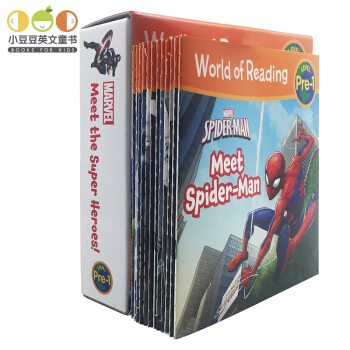
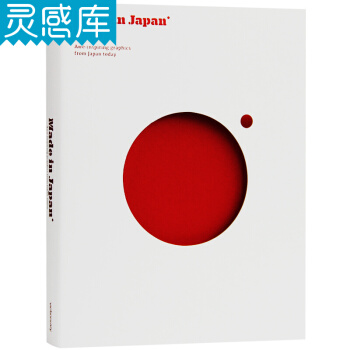
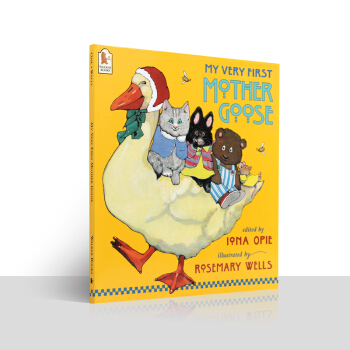
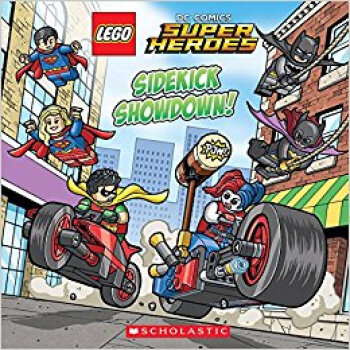
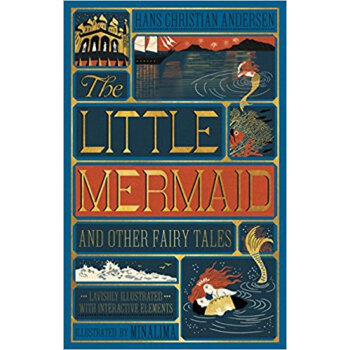
![Cambridge Dictionary of American English (2nd Edition) 劍橋美國英語詞典 英文原版 [平裝] pdf epub mobi 電子書 下載](https://pic.windowsfront.com/19000795/rBEhWFMW64wIAAAAAABWnBNjB4AAAJfGQIETD8AAFa0569.jpg)
![Two Bad Ants [精裝] [4歲及以上] pdf epub mobi 電子書 下載](https://pic.windowsfront.com/19021697/9387090e-d1d3-405c-a15e-cbd98c06f319.jpg)
![The J.R.R. Tolkien Audio Collection [Audio CD][J.R.R.托爾金有聲閤集] [平裝] pdf epub mobi 電子書 下載](https://pic.windowsfront.com/19104324/550fa7feN1fc439ab.jpg)
![What I Wish I Knew When I Was 20 [精裝] pdf epub mobi 電子書 下載](https://pic.windowsfront.com/19106887/550bee81N65a9bdd5.jpg)
![Henry James Literary Criticism 英文原版 [平裝] pdf epub mobi 電子書 下載](https://pic.windowsfront.com/19132784/rBEIDE-9_iIIAAAAAAEoOoaQCL4AAAI8gJHmjgAAShS932.jpg)
![John DOS Passos [精裝] [18--UP] pdf epub mobi 電子書 下載](https://pic.windowsfront.com/19132923/59da2953-ae43-4824-bd51-39859c25db6a.jpg)
![QBQ! The Question behind the Question: Practicing Personal Accountability at Work and in Life [精裝] pdf epub mobi 電子書 下載](https://pic.windowsfront.com/19134163/rBEQWVFrsa0IAAAAAAS8CuHnHVMAAEJbQDIBMsABLwi400.jpg)
![Mastering the Art of French Cooking: Vol.1 [精裝] pdf epub mobi 電子書 下載](https://pic.windowsfront.com/19230704/e7bcb6e2-c450-4ab1-8725-d63e8b7cbf95.jpg)
![Persuasion (Penguin English Library)[勸導] [平裝] pdf epub mobi 電子書 下載](https://pic.windowsfront.com/19279104/rBEQYFGI0tcIAAAAAAMt0cKzg5oAAAi-gCh6IUAAy3p319.jpg)
![Discover Germany (Lonely Planet Discover Country) 孤獨星球:發現德國 [平裝] pdf epub mobi 電子書 下載](https://pic.windowsfront.com/19281576/rBEQYFGDbegIAAAAAACfdCtz-MoAAAPyAOFpBkAAJ-M324.jpg)
![The Chronicles of Narnia Box Set (Books 1 to 7) 納尼亞全集 [精裝] [8歲及以上] pdf epub mobi 電子書 下載](https://pic.windowsfront.com/19287129/550fa63eNa9ff91c3.jpg)
![Encyclopedia Prehistorica Sharks and Other Sea Monsters: The Definitive Pop-Up [精裝] pdf epub mobi 電子書 下載](https://pic.windowsfront.com/19290237/rBEhU1JbdDkIAAAAAABc6fv8vGMAAEGxgIl39MAAF0B442.jpg)
![Your Inner Fish: A Journey into the 3.5-Billion-Year History of the Human Body [平裝] pdf epub mobi 電子書 下載](https://pic.windowsfront.com/19293747/rBEhVFJYJn0IAAAAAABaA-epP9cAAECagJSC3gAAFob906.jpg)
![The Prequel Trilogy: Star Wars 英文原版 [平裝] pdf epub mobi 電子書 下載](https://pic.windowsfront.com/19294915/rBEhU1JU0AwIAAAAAABQjCNEnuIAAD61ADIf3IAAFCk497.jpg)